Parasol and Shaggy Parasol mushroom – Edibility, Distribution, Identification.
Parasol Mushroom – Macrolepiota procera
- Edibility – 5/5 – fry caps whole in butter, batter and deep fry, stuff and roast drumsticks. Stipes tough and fibrous – use in stock pot.
- Identification – 4/5 – the most beautiful and striking of all wild mushrooms. Cap 15-35cm, cream with concentric brown scales, central umbo; Stipe up to 35cm, pale with dense brown ‘snakeskin’ pattern, bulbous base and prominent moveable double ring; Gills cream/white; flesh unchangingly white. Be aware that there are some highly toxic members of the leptiota family, including the fatal dapplerling (Lepiota brunneoincarnata). This is blissfully quite scarce in the UK, growing in forests and lacking a ring on the stipe. Stick closely to the identification features listed above, and you won’t go wrong.
- Distribution – 2/5 – very enigmatic and seldom in groups of more than 3 when I find them in Galloway. More common and gregarious further south.
- Season July-November
- Habitat: Unimproved pasture, machar, hedgerows, lawns and wood edges
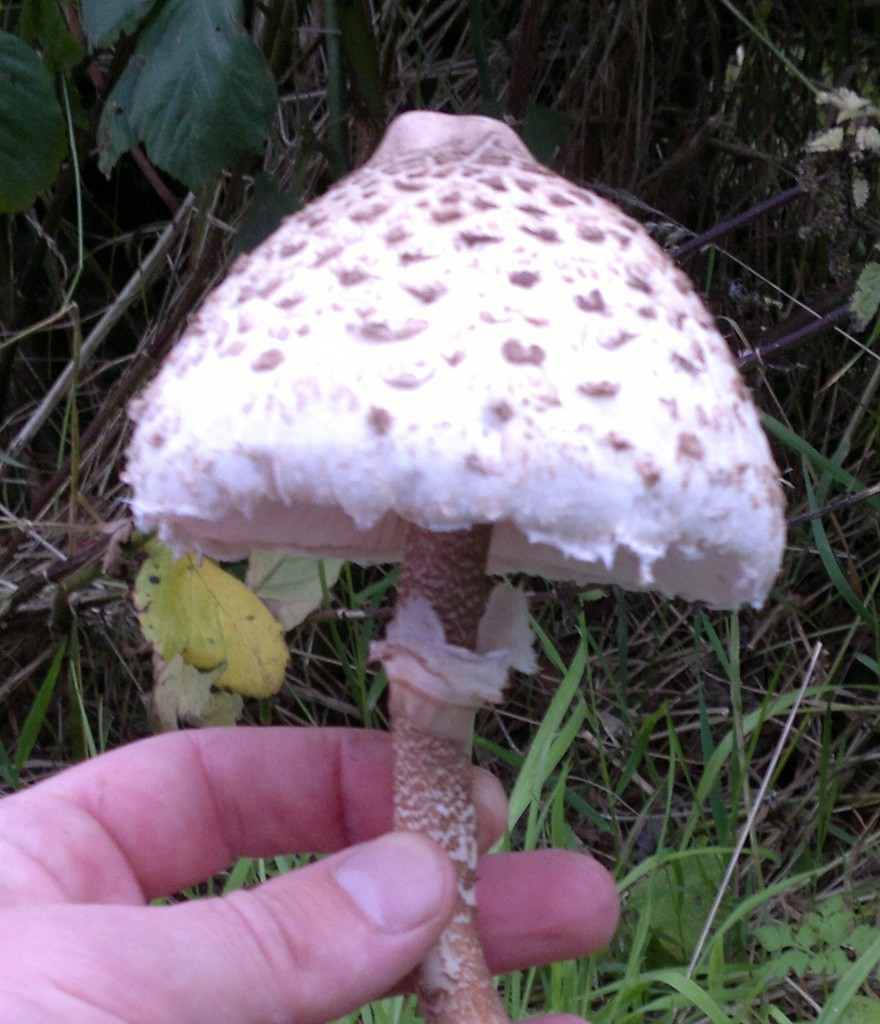
Parasol Mushroom, Macrolepiota procera. Note the snakeskin patterns and elaborate, moveable ring on the stem.
These are visually stunning mushrooms and almost as good gastronomically, made all the more special by their relative scarcity – I seldom find more than a handful a year. You don’t need to find many though – they can grow very large. The one below was 45cm tall and 35cm across the cap!
If you think you have found a parasol, but it is smaller, darker, shaggier-looking on the cap, lacking the snakeskin pattern on the stipe, and stains red when you cut the base, you may have found the related shaggy parasol, Chlorophyllum rhacodes. Although not quite in the same league as its big cousin, it is also a fine edible mushroom, though it doesn’t agree with some people. To be sure its for you, eat just a small amount, well cooked, the first time you try it. It is more of a lurker than the true parasol, often found in hedgerows and shady spots under trees on rich soil.
Related pages:
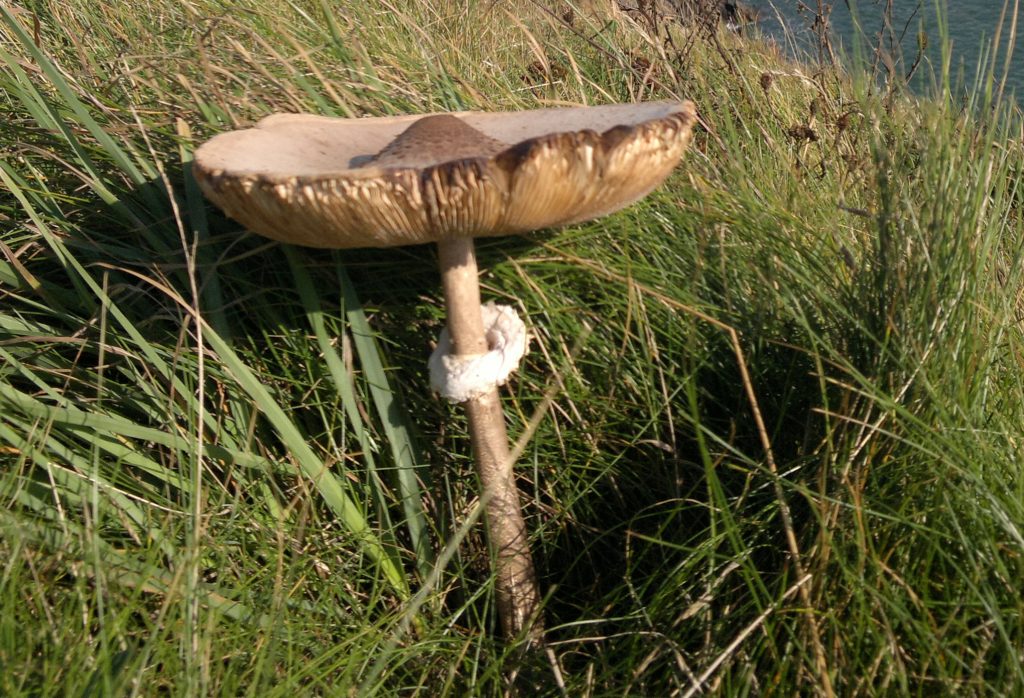
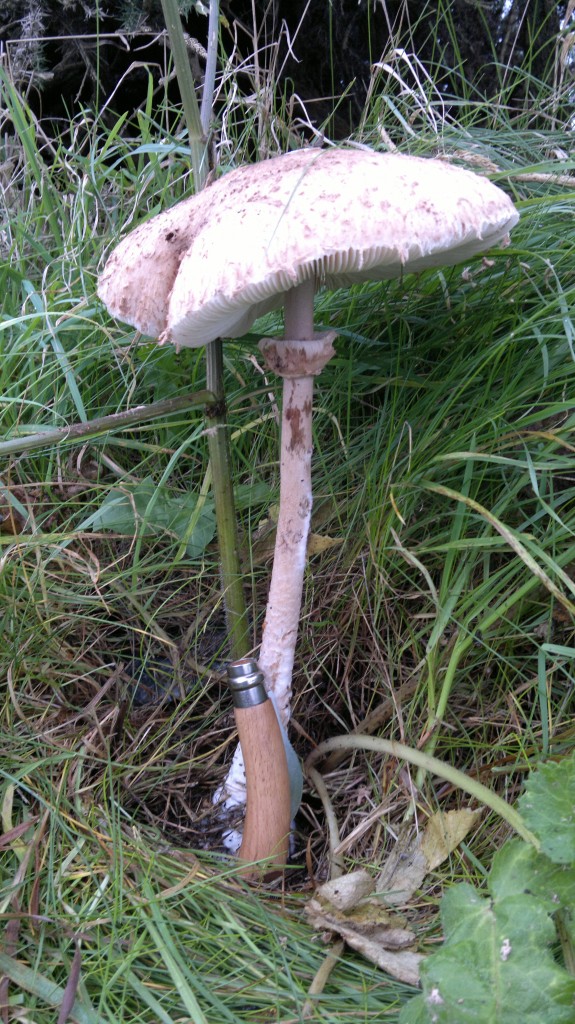
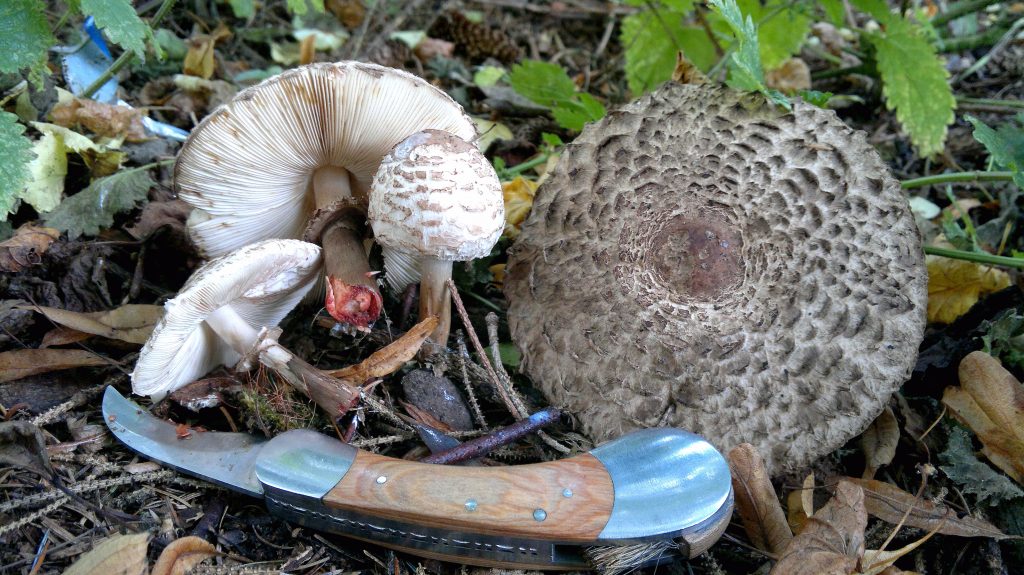
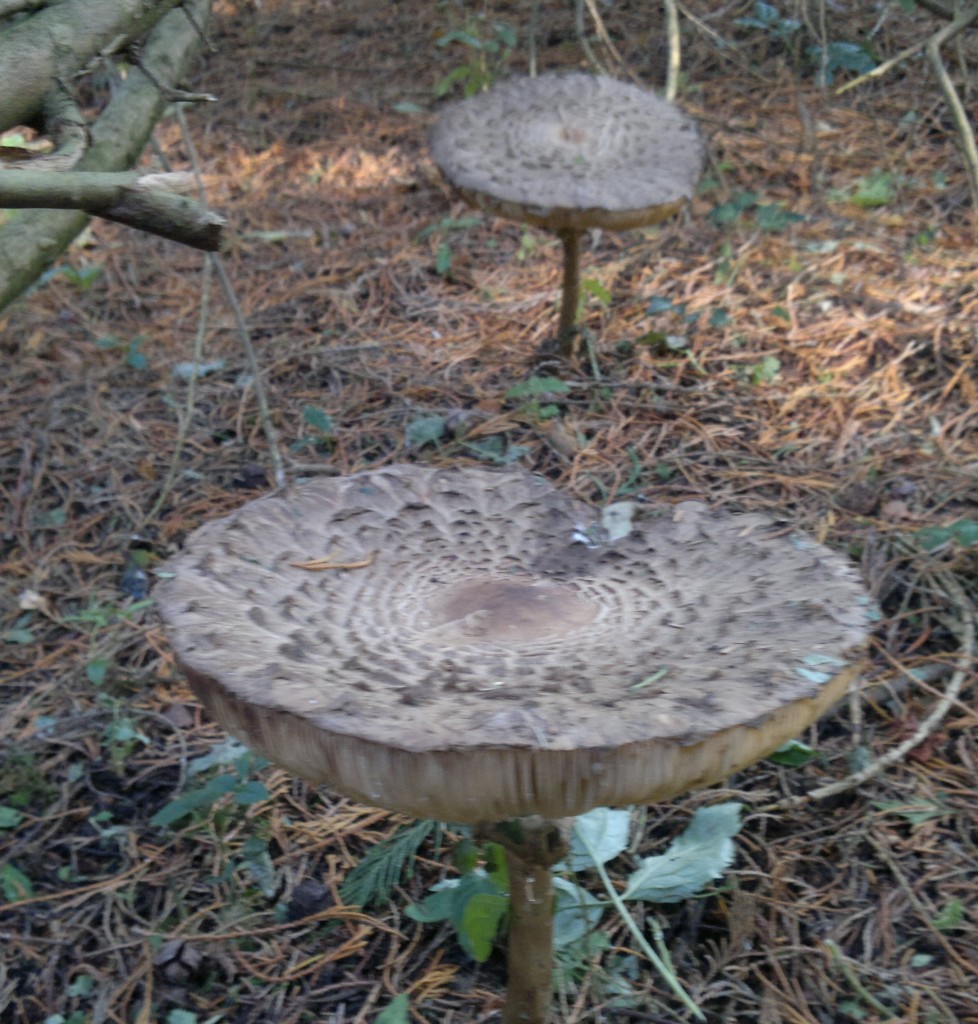
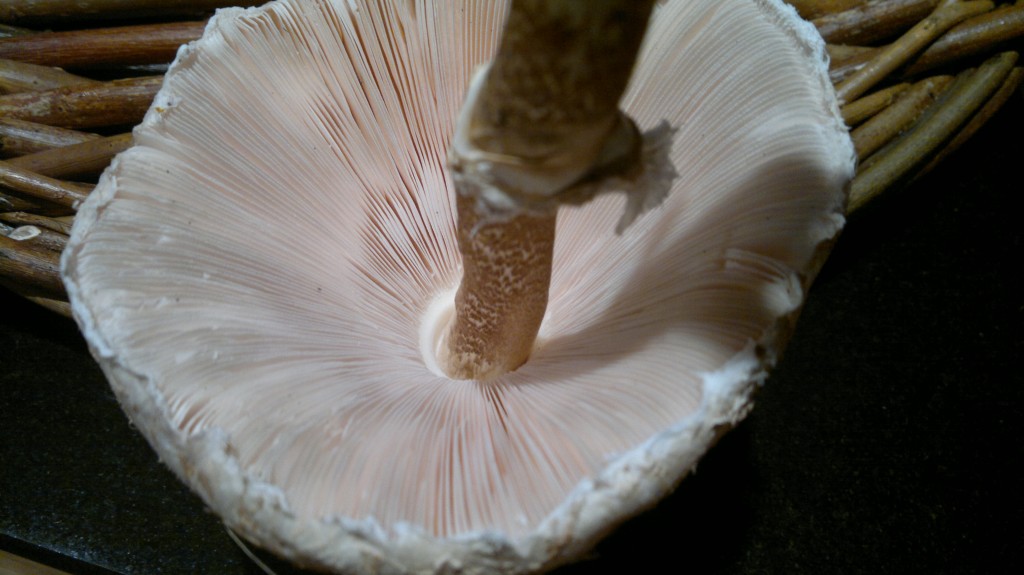
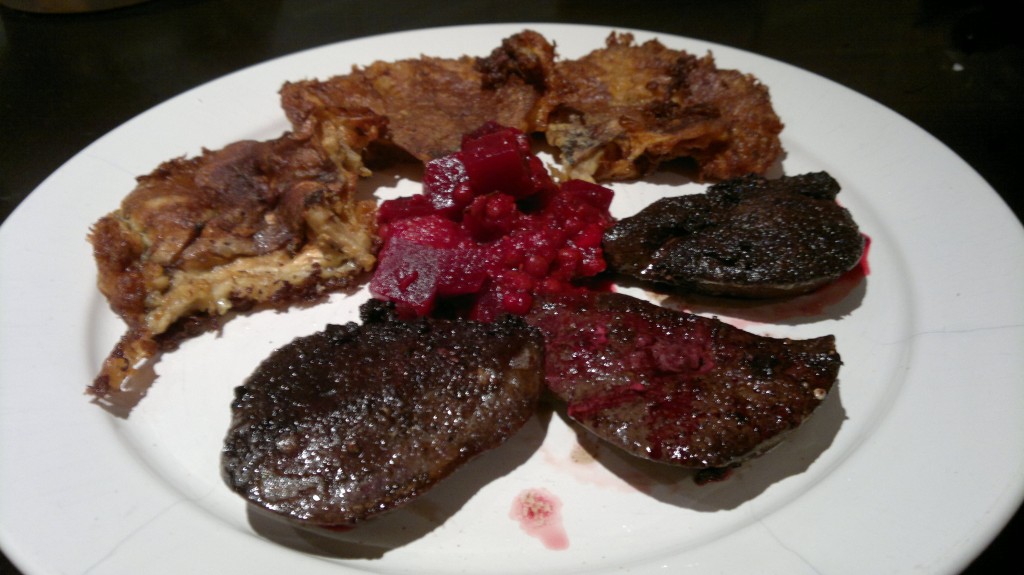
26 Comments
Parasols have a symbiotic relationship with red ants, the ones that make ant hills. If you find ant hills you should be able to find parasols. If you manage to find ant hills but no parasols then you can do them a big favour be feeding them small pieces of parasol which they take down into their hill to farm. You can use bought sporn as well but. Unfortunatly sporn is usaly on grain which rats and birds love to eat too so cuver well with some grass and wire netting to keep the rats off. They don’t actually eat the mysilium or the mushrooms, rather the use it as a sort of antibiotic. I can remember reading this but can’t remember where so can’t give you the link.
Thanks Mike, that’s fascinating. There is some interesting work going on just now researching the relationship between bees and mycelium. See here: https://www.youtube.com/watch?v=DAw_Zzge49c.
I’m sure ants are using fungi in similar ways.
I think I found one on someone’s lawn. And it meets ur requirements and the mushroom guide books Id requirements. Just nervous about cutting it and eating it. It’s my first time picking mushrooms .
I get like this Cheryl. I sort of reluctance even though you know deep down you have the right find.
Just found two large groups of these in north sutherland. cant wait to try the recipes.
I’ll post photos on the facebook page.
I have a patch 10 – 20 shaggy parasols in my back yard in Thessalon On. Can Still a little ify about trying, but after reading cmments will have a go.
Just found the local pine plantation littered with Shaagy Parasols. Six large trayfuls of sliced caps have oven dried down to four small trayfuls. I plan to store them in jars with a muslin pouch of seasalt. I broke some dried pieces into last night’s omlette. Some parallel could be made in the difference between sun dried tomatoes and fresh tomatoes. Wish I could post the smell in the house as they were drying.
There are loads about here in Malvern. I am going to make breakfast with them
Just found some in West Malvern funnily enough. Stumbled on this link whilst assessing their munchability.
Quite a large number every year in my parents’ field in Central Brittany. In French they’re called ‘coulemelles’, and any pharmacien in France will professionally ID fungi for free.
Has anyone been advised to “pre-boil before cooking”? One Finnish mushroom book recommends boiling *before* cooking “Akansieni”, which it classifies as Chlorophyllum Olivieri, whilst a second book classifies as Chlorophyllum Rhacodes. In contrast, English websites and videos advise simply chopping the raw mushroom before frying it. One website even advises against using excessive water when cleaning the Shaggy Parasol, in case the meaty taste is washed away.
I spoke to some Finnish mushroom academics who indicated that the reason for boiling Chlorophyllum rhacodes was to lessen the effect of the chemicals that make some sick (1 in 25 people), otherwise the mushrooms can be cooked without pre-boiling.
I have what I believe to be a prolific faery ring that returns every year. I feel certain they are parasols. I do not now the proper terminology. They are shaped like a parasol, tan, gilled and with a moveable membrane on the stem…the gills are light pinkish.
Can anyone here help me out? Thanks
Sounds likely, but no way to be sure without good photos.
Great mushroom.
I found a woodland with dozens of them
Only picked two for lunch.
Any ideas/tips how to preserve them?
I might go back to pick the rest.
They dry well. 🙂
I have recently read a very interesting article in a Spanish magazine specialized in mushrooms, etc., and in there they talked about ‘Macrolepiota venenata’, a toxic species that apparently is quite similar to “Macrolepiota/ Chlorophyllum rhacodes”. In fact, the clearest difference mentioned in the article is that the Macrolepiota (Chlorophyllum?) venenata grows in clusters, instead of separate individuals. According to the article, this is an invasive non-European species introduced via some xmas trees imported from America. Has anyone ever come across this one? The link to the Spanish article is this one: https://www.cestaysetas.com/macrolepiotas-lepiotas-intoxicaciones/ (but the text is in Spanish, unfortunately)
That’s interesting – thanks for sharing Bernardo. I can’t decipher the Spanish, but haven’t heard of M/C venenate in the UK yet.
I found Macrolepiota Procera in September of 2019. Unfortunately, 2020 was a drought year, so nothing showed. I live in North Dakota of the USA and found them north of Bismarck the capitol, and just west of the Missouri. West of the Missouri is semi-arrid country with sandy soil. Cacti grow here although they are small. I hope fungi will show this year. I am new to this, so how many should I pick/leave. Second, does it help to drop spores, or drop in a new area? Not many people pay attention to fungi or wild berries here. Undoubtedly in part because N.D. has excellent hunting and fishing opportunities. I also pick and make wild jams. Fifty years ago this was common but now it is uncommon to rare. The Bulberry or Buffaloberry makes a superb, unique jam; though I was amazed to read the oppinion to pass them by. The flavor is citrus like with a hint of tropical. Unbelievably, it is native to North Dakota which has no citrus and no tropical due to cold winters. Email: 18chaps@gmail.com.
Found some shaggy parasols today in Essex. Very tasty indeed! So exciting when you can eat from the land 🙂
I just ate my first parasol mushrooms. I was already 90% sure they were parasol mushrooms when I picked them, then checked with all your info and was 98% sure. They tasted good, thank you for the back up!
We, that is my 5 year old son, Ben and I have found a fairy ring of parasol mushroom, 30 to 40 mushrooms in a 30 foot diameter ring. They fruited in August but the hot weather dried the caps up, 38 degrees and windy. They have started fruiting again now cooler and wetter in mid September. Location old sheep field in North Yorkshire
I ate two that looked liked parasols with a diameter of more than 12 cm with the distinctive pattern on the top and the movable skirt on the stipe. It had a bulbous base but I didn’t see the snake pattern on the stipe. They were creamy white and did not taste bitter at all so I don’t think they were shaggy parasols.
From what I’m reading this looks like the typical parasol? I left it alone because I didn’t know what it was.I don’t see where I can post a picture but it was enormous and only one. It was a tight bulb it did not send out into like a small plate. It was cream colored but more whitish with definitely those snake skin darker caramel colored little pieces sticking out all over it.
Hello all.
I have some growing in my garden, I have been watching the cap forming for a few days and only today decided to identify them, There are two very close to each other There caps overlapping and a smaller one that has fallen over, I had not known the third one was there until I looked at my pictures. I might go and see if it will stand back up tomorrow. Pity I can’t attach a picture.
Trevor
Just had an allergic reaction after eating Parasols – my hands and feet and unside my ears became unbearably itchy. This is the same reaction I had when I became allergic to penicillin. So, I wondered if Parasols contain penicillin, or a similar antibiotic? Intetesting the comment above mentions ants.use Parasol fungus as antibiotics.